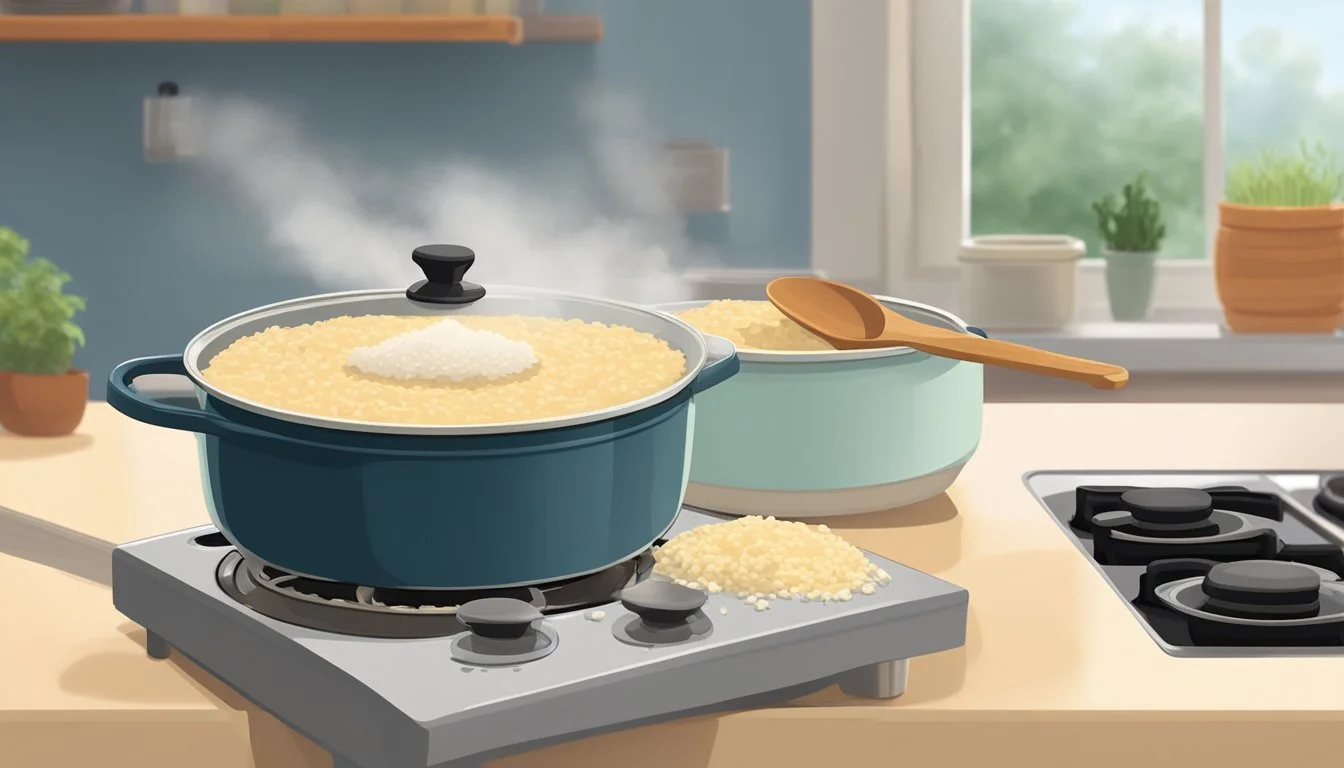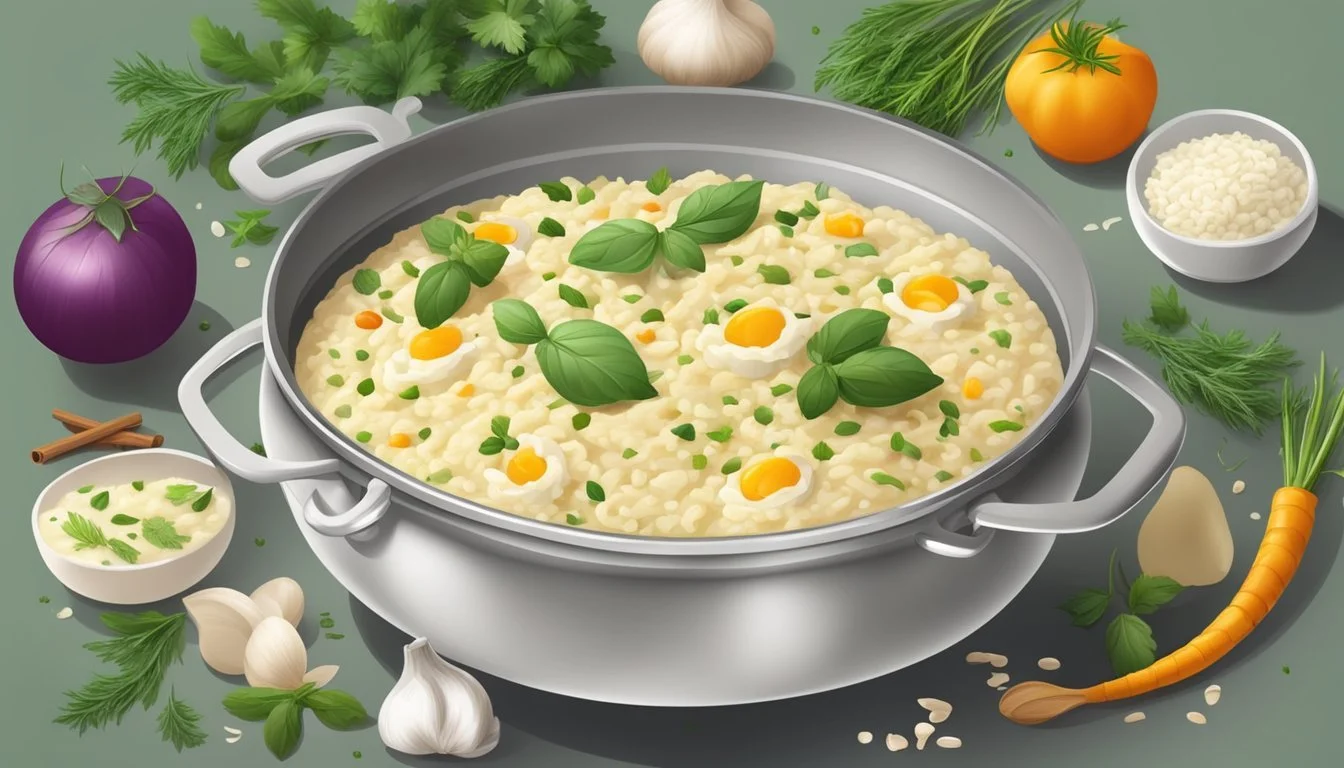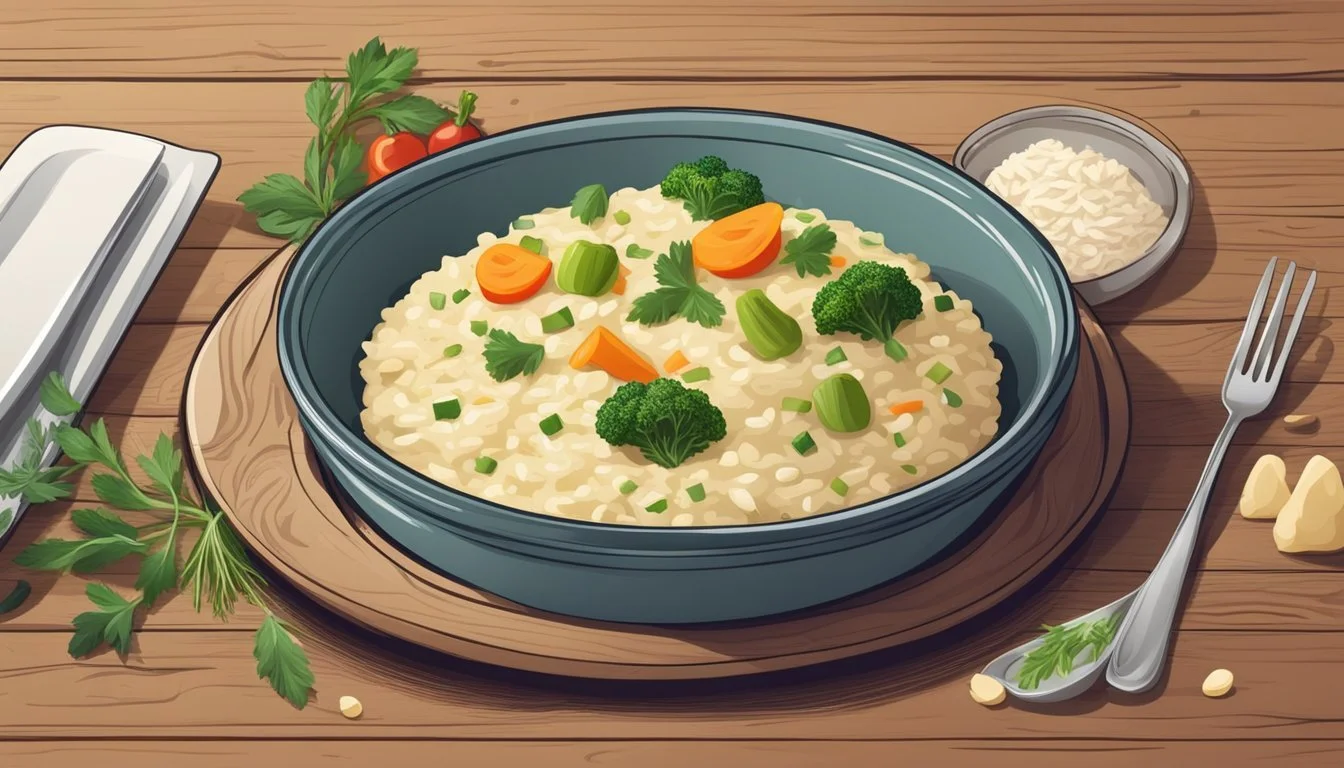Is Risotto Gluten-Free?
Understanding the Ingredients and Preparations
Risotto is an Italian dish known for its creamy consistency and is typically made from a starchy variety of rice known as Arborio. At its core, risotto might seem inherently gluten-free because it is rice-based; rice is a grain that does not contain gluten. However, the gluten-free status of a risotto dish is not just about the rice; it also depends on the other ingredients used in preparation, including the broth, any added sauces, and accompaniments.
For individuals with celiac disease or gluten sensitivity, the details matter greatly. Broths and stocks, often essential to the rich flavor of risotto, can sometimes contain gluten if they use certain additives, flavorings, or preservatives. Similarly, any garnishes or additional ingredients must also be scrutinized. Even with all ingredients being gluten-free, the risk of cross-contamination during the growing, processing, or cooking stages could potentially render a seemingly safe dish unsafe for those avoiding gluten.
Consequently, while a basic risotto recipe might be gluten-free, diners and cooks should examine all elements of the dish before assuming it is safe for a gluten-free diet. Understanding the complete ingredient list as well as the preparation process remains critical in ensuring that a risotto dish does not inadvertently contain gluten.
What Is Risotto?
Risotto is a creamy Italian rice dish known for its rich texture and depth of flavor, traditionally made with arborio rice, broth, and often dressed with butter and Parmesan cheese. It involves a meticulous cooking process that includes constant stirring to achieve its characteristic creaminess.
Origins and Cultural Significance
The dish originates from Northern Italy, with Milan being noted for its significant role in the history of risotto. It has been an integral part of Italian cuisine since the Middle Ages and has become a symbol of the ingenuity of Northern Italian cooking. Risotto is deeply ingrained in the culinary culture of Italy and is esteemed both for its simplicity and its complexity in flavor.
Key Ingredients
The principal ingredient:
Rice: Specifically, a high-starch variety like Arborio rice is used, which is key to the dish's creamy texture.
Broth: Typically chicken, vegetable, or beef broth, provides the liquid and is absorbed by the rice during cooking.
Butter and Olive Oil: Used at the beginning to sauté onions and at the end to finish the dish, adding a rich mouthfeel.
Cheese: Usually Parmesan cheese is stirred in at the end to enhance flavor and texture.
Basic Risotto Preparation
Risotto preparation begins with sautéing onions in butter or olive oil. The arborio rice is then toasted slightly before being cooked. Broth is added incrementally, and the rice is stirred continuously. This stirring helps release the rice's starches, creating the dish's hallmark creamy consistency. The process of adding broth and stirring is continued until the rice becomes al dente. Before serving, additional butter and Parmesan cheese are often folded in to enrich the flavor and creaminess.
Assessing Gluten Content
In determining whether risotto is suitable for a gluten-free diet, one must examine the gluten presence, the natural composition of risotto, and the importance of checking ingredient labels.
Understanding Gluten
Gluten is a group of proteins found in wheat, barley, and rye, and it can be a concern for individuals with celiac disease or non-celiac gluten sensitivity. It's crucial for them to avoid gluten because it triggers harmful reactions in their bodies.
Is Risotto Naturally Gluten-Free?
Rice, the primary ingredient in risotto, is naturally gluten-free. However, the gluten status of risotto can be compromised through cross-contact with gluten grains during growing, processing, or preparation. Additionally, other ingredients such as broth or sauces might contain gluten unless specified as gluten-free.
Reading Labels for Gluten
When assessing packaged risotto or ingredients for homemade versions, scrutinize the label for:
The certified gluten-free mark, confirming the product meets strict gluten-free standards.
A list of all potential gluten-containing ingredients (wheat, barley, rye, or derivatives).
Warnings of possible cross-contamination if processed in a facility that also handles gluten grains.
Ingredients and Substitutions
When preparing gluten-free risotto, selecting the right ingredients and understanding possible substitutions is crucial for maintaining its gluten-free integrity while catering to dietary preferences or restrictions.
Rice Varieties
Arborio rice is the traditional choice for risotto due to its high starch content, which contributes to the dish's creamy texture. For gluten-free risotto, it's important to ensure that the rice is not cross-contaminated with gluten-containing grains. Alternatives to arborio include carnaroli and vialone nano, which also make excellent gluten-free risottos.
Broth Variations
The broth is a foundational component of risotto, imparting flavor and aiding the cooking process of the rice. Use vegetable or meat broths, ensuring they're labeled gluten-free. For a dairy-free or vegan variation, opt for vegetable broth and replace butter with oil such as olive oil.
Vegetable Broth: Great for a vegan base or with vegetables like broccoli, peas, or butternut squash.
Chicken/Mushroom Broth: Complements add-ins like chicken, mushrooms (What wine goes well with mushrooms?), or shrimp.
Alternative Add-ins
Gluten-free risotto can be tailored with a variety of add-ins. Replace traditional parmesan cheese with a dairy-free alternative or nutritional yeast to achieve a vegan risotto. For proteins or vegetables, options like chicken, shrimp, asparagus, peas, and butternut squash are excellent choices. Consider garnishing with fresh herbs like parsley for added flavor.
Vegetables: Broccoli, peas, mushrooms, asparagus, butternut squash
Proteins: Shrimp, meat (ensure gluten-free if using processed meats)
Garnishes: Fresh parsley, other herbs
Cheese: Parmesan, or dairy-free/vegan alternatives
Incorporating these variations requires attention to each ingredient's properties to retain the creamy texture and rich flavor characteristic of traditional risotto while keeping it gluten-free.
Preparing Gluten-Free Risotto
When crafting a gluten-free risotto, the focus is on selecting the right cookware, minimizing cross-contamination risks, and employing gluten-free cooking techniques to maintain the dish's integrity and creamy texture.
Choosing Safe Cookware
One must ensure that the saucepan or dutch oven used for preparing gluten-free risotto does not harbour gluten residues. It's advisable to use pots and pans designated specifically for gluten-free cooking, or thoroughly clean them if they have previously been used for gluten-containing foods. Many prefer a heavy-bottomed dutch oven for even heat distribution or a non-stick saucepan to prevent sticking and burning of ingredients.
Cross-Contamination Risks
Kitchens can be rife with cross-contact points where gluten-containing ingredients contaminate gluten-free foods. To avoid such risks, separate utensils and cutting boards should be used for gluten-free ingredients. Additionally, preparation surfaces must be diligently cleaned before starting, and utensils should be dedicated solely to gluten-free use or thoroughly washed to prevent cross-contamination.
Gluten-Free Cooking Techniques
When developing a gluten-free risotto recipe, it is essential to utilize gluten-free ingredients and procedures. Gluten-free risotto typically requires 30 minutes to cook on the stove, with continuous stirring to foster the creamy texture risotto is known for. Broth used in the risotto should come from a trusted gluten-free certification organization to ensure safety. Cooking may be started on the stove and finished in the microwave if necessary to reduce the risk of exposure to gluten.
Health and Nutrition Considerations
When considering risotto in terms of health and nutrition, one must not only assess its caloric and macronutrient content but also its suitability for various dietary restrictions and allergies.
Caloric and Macronutrient Profile
Risotto's nutritional profile can vary depending on the ingredients used. However, a typical 100-gram serving of prepared risotto could provide approximately 368 calories, with 6.1 grams of total fat (including saturated fat), around 1193 mg of sodium, 66.7 grams of carbohydrates, including sugars, and approximately 12.3 grams of protein. Risotto is not a significant source of dietary fiber, often containing less than 1 gram per serving.
Nutrient Amount per 100g Serving Calories 368 kcal Total Fat 6.1 g Saturated Fat Not specified Sodium 1193 mg Carbohydrates 66.7 g Fiber < 1 g Sugars 7 g Protein 12.3 g
Dietary Restrictions and Allergies
Risotto typically contains rice, which is a gluten-free grain. However, it may not always be safe for individuals with celiac disease or gluten sensitivity, as the broth or other ingredients could contain gluten. People should verify whether the broth is gluten-free and be aware of potential cross-contamination with gluten-containing grains during processing.
For those with dairy allergies or following a dairy-free or vegan diet, traditional risotto, which often contains cheese and butter, may not be suitable unless modified with dairy-free alternatives. A thorough examination of the ingredients list is essential for those with dietary restrictions to ensure that the risotto aligns with their nutritional needs and restrictions.
Risotto in Dining Out
When considering risotto options at restaurants, customers with gluten sensitivities need to be vigilant. Not all risotto dishes are guaranteed to be gluten-free, as some ingredients may contain gluten or there could be cross-contamination from gluten-containing products.
Restaurant Risotto Options
Restaurants typically offer risotto as a rich and creamy rice dish, which can be gluten-free if it consists of classic ingredients like arborio rice, cheese, olive oil, and chicken. The rice itself is naturally gluten-free, but diners should be aware that certain additions or cooking methods might introduce gluten. Here's a brief breakdown of common risotto components found on menus:
Base ingredients: Arborio rice, broth, wine.
Proteins: Chicken, seafood, often gluten-free.
Fats: Olive oil, butter.
Questions to Ask at a Restaurant
To ensure a risotto dish is gluten-free, customers should make inquiries regarding preparation and ingredients. Important questions include:
Broth: Is the broth used in the risotto certified gluten-free?
Seasonings: Are any seasonings or thickeners containing gluten used in cooking the risotto?
Cross-contamination: Does the kitchen have a dedicated area to prevent cross-contamination with gluten-containing ingredients?
Cookware: Are separate utensils and cookware used for gluten-free dishes?
Asking these specific questions can help those dining out to confidently select a gluten-free risotto and enjoy their meal without concerns over dietary restrictions.
Expanding on Risotto Variations
Risotto's adaptability allows for countless variations, inviting a blend of traditional and novel ingredients. Whether enhancing it with vegetables, infusing it with seafood, or keeping it simple and savory, risotto is a showcase for culinary creativity.
Culinary Creativity with Risotto
Risotto serves as a canvas for a wide range of flavors and textures. Key ingredients like Carnaroli or Lundberg rice ensure the dish’s iconic creaminess. Chefs may incorporate mushroom, garlic, onion, and parsley for a rich, aromatic base. For brightness and acidity, lemon zest and juice are often added. Risotto can be enriched with cheese, like creamy Parmesan, offering a smooth, velvety finish.
Creative spins on risotto might include grains like pearled barley for a nutty taste and heartier texture. Herbs, saffron, and various spices give distinct regional flares—ranging from the subtle to the bold. Salt and pepper are essential for seasoning, enhancing the natural flavors of the ingredients.
Popular Risotto Combinations
The traditional risotto can take on various forms. Popular combinations often feature:
Seafood Risotto: Combining ingredients like shrimp and other seafood with lemon and parsley.
Mushroom Risotto (What wine goes well with mushroom risotto?): Utilizing different types of mushrooms, often with garlic, onion, and Parmesan.
Vegetable Risotto: Incorporating roasted vegetables, spinach, or asparagus for added health benefits and texture.
Sausage Risotto: Offering a hearty protein option with a variety of sausage, often paired with herbs and spices.
A table of popular risotto combinations includes:
Ingredient Pairing Suggestions Seafood Lemon, parsley, garlic, saffron Mushroom Garlic, onion, creamy Parmesan, parsley Vegetables Roasted veggies, spinach, asparagus, spices Sausage Onion, garlic, Parmesan, pepper
Each ingredient in these combinations is chosen for its ability to meld harmoniously into the risotto, creating a balanced and satisfying dish.
Serving and Presentation
When serving risotto, its creamy texture and rich flavor profile offer an ideal canvas for a variety of garnishes and pairings with numerous dishes. Attention to these details can greatly enhance the dining experience.
Garnishing and Final Touches
Risotto's visual appeal is almost as important as its taste. Once plated, a sprinkle of freshly grated Parmesan adds a salty, umami layer. Adding herbs like fresh parsley, chives, or basil can introduce color and a subtle flavor contrast. For a zestier finish, a twist of lemon zest may be included not only as a bright garnish but also to cut through the richness of the dish.
Pairing with Main Courses and Side Dishes
Generally served as a hearty side dish, risotto complements a diverse array of main courses. For meat lovers, it pairs well with roasted or grilled meats—chicken or beef are classic partners. Vegetarians might prefer it alongside grilled peppers and zucchini. To balance its creamy texture, serving it with a dish that has a bit of acidity or a crunchy texture can complement the overall meal beautifully.
Storage and Reheating
When storing and reheating risotto, maintaining its creamy texture is paramount. It's essential to use the correct techniques to ensure that the quality of the dish is preserved, whether it's straight from the stove or being enjoyed as leftovers.
Best Practices for Refrigeration
For optimal freshness, risotto should be placed in the fridge within two hours of cooking. The risotto needs to be stored in a shallow airtight container to minimize exposure to air. This method also helps the risotto to cool evenly and quickly, reducing the risk of bacterial growth.
Steps for refrigerating risotto:
Spread the risotto in an even layer for rapid cooling.
Seal the container tightly to keep out moisture and other flavors.
Label the container with the date. Cooked risotto can be safely refrigerated for up to 5 days.
Reheating Without Compromising Quality
Reheating risotto requires gentle heat and additional liquid to restore its creamy consistency. Using a microwave or stovetop are the two common methods for reheating.
Stovetop Method:
Heat a small amount of broth or water (about 1/4 cup for each cup of risotto) in a pot until simmering.
Add the cold risotto, stirring gently.
Simmer on low heat, adding more liquid as needed, until the risotto is heated through and creamy.
Microwave Method:
Place risotto in a microwave-safe dish.
Sprinkle a few tablespoons of water or broth over the risotto to reintroduce moisture.
Cover with a microwave-safe lid or plastic wrap, venting the side for steam release.
Reheat on medium power in increments of 90 seconds, stirring between each interval, until hot.
It's crucial not to overheat as it can dry out the risotto and affect its texture. Risotto should have a creamy, not dry or stiff, consistency upon reheating.
Homemade Risotto Tips
Homemade risotto stands out as comfort food with its creamy texture and customizable nature. Engaging in the process with precision and understanding will enhance the dish's quality, ensuring a delightful dining experience.
Time-Saving Techniques
When preparing risotto, it’s beneficial to keep to a 30-minute window to balance efficiency and taste. Using a stove with a consistent heat source is vital. To save time, one should have all ingredients measured and prepared before starting, as risotto cooking demands attention. Pre-heating the liquid – whether it’s water or broth – in a separate pot can also expedite the process. Incorporating white wine, preferably dry white wine, should be done before adding the broth, as it needs time to absorb and cook off the alcohol, paving the way for the rice to release its starches slowly.
Organize Ingredients: Measure broth, water, and wine ahead of time.
Consistent Heat: Use medium heat to avoid rapid evaporation.
Pre-heat Liquids: Keep broth or water at a simmer in a separate pot.
Crafting the Perfect Creaminess
The hallmark of excellent risotto lies in its luxuriously creamy texture. Choosing the right rice, such as arborio, is crucial as it contains high starch content. Constant stirring is not a myth; it facilitates the even release of starch, which contributes to the creaminess. However, over-stirring can lead to a gummy texture, so one should stir often, but with care. Gradually ladle in the hot broth, allowing the rice to absorb it slowly, enhancing both texture and flavor. For a touch of richness, finish with a pat of butter or a sprinkle of quality cheese.
Select the Proper Rice: Use arborio rice for optimal creaminess.
Balance Stirring: Stir frequently but not incessantly.
Add Liquids Slowly: Introduce broth or water one ladle at a time.
Finish with Fats: Incorporate butter or cheese at the end for a richer taste.
Gluten-Free Risotto Recipes
Crafting a delicious gluten-free risotto relies on carefully selecting ingredients that avoid gluten while maintaining the creamy texture and rich flavor risotto is known for. Here are specific recipes that remain faithful to the classic dish and offer inspired variations for those seeking gluten-free options.
Classic Risotto Recipes
The foundation of a Classic Gluten-Free Risotto offers a rich, creamy texture that relies on inherently gluten-free arborio rice. To begin, one heats a drizzle of olive oil in a pan and sautés finely chopped shallots or a white onion until translucent. One then adds the rice, stirring to toast it lightly before deglazing the pan with white wine if desired. Gradually, warmed chicken broth is added in intervals, allowing the rice to absorb the liquid and release its starches.
Essential Herbs and Seasoning:
Salt and freshly ground black pepper to taste
A selection of fresh herbs like thyme, basil, or parsley for added depth
This traditional approach ensures a gluten-free result that does not compromise on authenticity or flavor.
Innovative Gluten-Free Options
For those interested in exploring beyond the classic, Innovative Gluten-Free Risotto recipes incorporate an array of flavors while keeping the dish gluten-free. One such variation might introduce wild mushrooms for an earthy taste, or butternut squash for a hint of sweetness and color. The process remains similar, with the addition of these components after the onions have softened.
Options for Enhanced Flavor and Texture:
Incorporate roasted garlic or leeks for a subtle, yet complex flavor profile
Fold in sautéed gluten-free vegetables like zucchini or roasted red peppers
Regardless of the variation, one ensures that all added ingredients, including any broth or seasoning, are verified to be gluten-free. This careful inclusion allows for a range of delicious, gluten-free risotto dishes that suit any palate.
Conclusion
Risotto is a versatile dish that can often cater to a gluten-free diet, as its primary ingredient is rice, which does not contain gluten. However, caution is advised, especially for individuals with celiac disease or gluten sensitivity. The culprits that may introduce gluten into risotto typically lie in the additional ingredients, such as the broth or any additives like bouillon cubes.
When preparing risotto at home, one has the advantage of customizing ingredients to ensure they are gluten-free. For a guilt-free comfort food experience, individuals must pay careful attention to labels, verifying that broth and other mix-ins adhere to gluten-free standards.
For those enjoying risotto in the company of friends or dining out, it’s important to communicate dietary restrictions to ensure the meal remains a safe and enjoyable experience for everyone. Chefs can often accommodate such requests, making risotto a suitable option for a convivial dining experience.
In summary, risotto can be a comfort food suitable for a gluten-free lifestyle, provided that all ingredients are carefully selected or verified to be free of gluten. This dish remains a favorite for many due to its creamy texture, heartiness, and the ease with which it can be tailored to suit different tastes and dietary needs.










